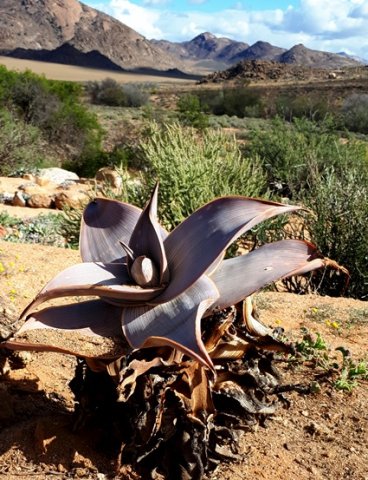Aloe karasbergensis

Aloe karasbergensis, previously known as A. striata subsp. karasbergensis, is a bulky, stemless or occasionally short-stemmed leaf succulent that branches, growing up to 20 rosettes. Especially when there are fewer, one rosette may be over 1 m in diameter and the plant in flower up to 1,8 m tall.
The blue-green to pink, bronze or purplish leaves change colour with the seasons. Summer drought and heat remove the green colouring, the chlorophyll, slowing down plant metabolism to meet the challenge of survival until the next rain, which may stay away for several years.
The smooth leaves have conspicuous surface striations and pale, cartilaginous margins that are sometimes jagged or crenulated but without spines. The leaf dimensions are 45 cm long and 17,5 cm wide near the base.
The inflorescence is a large, lax, many-flowered panicle comprised of small, pinkish to coral-red perianths, the flowers. Each perianth is slightly swollen at the base with greyish tips striped white and green. Flowering happens from midsummer to early autumn.
The species distribution is in the Richtersveld, northwards into southern Namibia to Aus and to the southeast as far as Prieska.
The habitat is succulent Karoo, Nama Karoo, semi-desert and desert in arid, winter rain conditions. The plants grow in sandy soil near dry riverbeds and on rocky slopes. The species is not considered to be threatened in its habitat early in the twenty first century (Frandsen 2017; Williamson, 2010; iNaturalist; http://pza.sanbi.org; http://redlist.sanbi.org).

